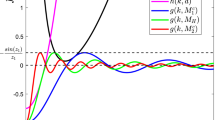Abstract
The effect of dispersal under heterogeneous environment is studied in terms of the singular limit of an Allen–Cahn equation. Since biological organisms often slow down their dispersal if food is abundant, a food metric diffusion is taken to include such a phenomenon. The migration effect of the problem is approximated by a mean curvature flow after taking the singular limit which now includes an advection term produced by the spatial heterogeneity of food distribution. It is shown that the interface moves towards a local maximum of the food distribution. In other words, the dispersal taken in the paper is not a trivialization process anymore, but an aggregation one towards food.


Similar content being viewed by others
References
Alfaro M, Hilhorst D, Matano H (2008) The singular limit of the Allen-Cahn equation and the FitzHugh-Nagumo system. J Differ Equ 245(2):505–565
Allen SM, Cahn JW (1979) A microscopic theory for antiphase boundary motion and its application to antiphase domain coarsening. Acta Metall 27(6):1085–1095
Ambrosio L (2000) Geometric evolution problems, distance function and viscosity solutions. In: Ambrosio L, Dancer N (eds) Calculus of variations and partial differential equations. Springer, Berlin, pp 5–93
Barles G, Soner HM, Souganidis PE (1993) Front propagation and phase field theory. SIAM J Control Optim 31(2):439–469
Bonami A, Hilhorst D, Logak E, Mimura M (2001) Singular limit of a chemotaxis-growth model. Adv Differ Equ 6(10):1173–1218
Chen X (1992) Generation and propagation of interfaces for reaction-diffusion equations. J Differ Equ 96(1):116–141
Cho E, Kim YJ (2013) Starvation driven diffusion as a survival strategy of biological organisms. Bull Math Biol 75(5):845–870
Choi SH, Kim YJ (2015) Chemotactic traveling waves by metric of food. SIAM J Appl Math 75(5):2268–2289
Choi SH, Kim YJ (2017) A discrete velocity kinetic model with food metric: chemotaxis traveling waves. Bull Math Biol 79(2):277–302
De Mottoni P, Schatzman M (1990) Development of interfaces in \({\mathbf{R}}^N\). Proc R Soc Edinb Sect A 116(3–4):207–220
Fife PC (1988) Dynamics of internal layers and diffusive interfaces. Society for Industrial and Applied Mathematics (SIAM), Philadelphia, PA
Giga Y, Goto S, Ishii H (1992) Global existence of weak solutions for interface equations coupled with diffusion equations. SIAM J Math Anal 23(4):821–835
Grayson MA (1987) The heat equation shrinks embedded plane curves to round points. J Differ Geom 26(2):285–314
Hilhorst D, Karali G, Matano H, Nakashima K (2007) Singular limit of a spatially inhomogeneous Lotka-Volterra competition-diffusion system. Commun Partial Differ Equ 32(4–6):879–933
Ilmanen T (1993) Convergence of the Allen-Cahn equation to Brakke’s motion by mean curvature. J Differ Geom 38(2):417–461
Kawasaki K, Ohta T (1982) Kinetic drumhead model of interface. I. Prog Theor Phys 67(1):147–163
Keller EF, Segel LA (1971) Model for chemotaxis. J Theor Biol 30(2):225–234
Ladyženskaja OA, Solonnikov VA, Ural’ceva NN (1968) Linear and quasilinear equations of parabolic type. Translations of mathematical monographs, vol 23. American Mathematical Society, Providence
Lou B (2003) Singular limit of a \(p\)-Laplacian reaction-diffusion equation with a spatially inhomogeneous reaction term. J Stat Phys 110(1–2):377–383
Mimura M, Tsujikawa T (1996) Aggregating pattern dynamics in a chemotaxis model including growth. Phys A Stat Mech Appl 230(3):499–543
Nakamura KI, Matano H, Hilhorst D, Schätzle R (1999) Singular limit of a reaction-diffusion equation with a spatially inhomogeneous reaction term. J Stat Phys 95(5–6):1165–1185
Okubo A, Levin SA (2001) Diffusion and ecological problems: modern perspectives, interdisciplinary applied mathematics, vol 14, 2nd edn. Springer, New York
Shigesada N, Kawasaki K, Teramoto E (1979) Spatial segregation of interacting species. J Theor Biol 79(1):83–99
Skellam JG (1972) Some philosophical aspects of mathematical modeling in empirical science with special reference to ecology. Mathematical models in ecology. Blackwell Sci. Publ., London
Skellam JG (1973) The formulation and interpretation of mathematical models of diffusionary processes in population biology. The mathematical theory of the dynamics of biological populations. Academic Press, New York
Acknowledgements
This research was performed in the context of the CNRS GDRI ReaDiNet. Hilhorst would like to thank the Center for Mathematical Challenges for the support during her visits at KAIST where this work was completed. Kim was supported in part by National Research Foundation of Korea under contact no. 2017R1A2B2010398. The authors are grateful for the ideas included in the unpublished article “Motion of interfaces in a spatially inhomogeneous Allen–Cahn equation with equal well-depth potential” by Hilhorst, Matano, and Schätzle.
Author information
Authors and Affiliations
Corresponding author
Rights and permissions
About this article
Cite this article
Hilhorst, D., Kim, YJ., Kwon, D. et al. Dispersal towards food: the singular limit of an Allen–Cahn equation. J. Math. Biol. 76, 531–565 (2018). https://doi.org/10.1007/s00285-017-1150-5
Received:
Revised:
Published:
Issue Date:
DOI: https://doi.org/10.1007/s00285-017-1150-5
Keywords
- Fokker–Planck type diffusion
- Food metric
- Singular limit
- Generation and propagation of interface
- Perturbed motion by mean curvature




